DATE – 2000
DISCIPLINE – Education
MEDIUM – Fish controlled robotic sculpture
STATUS – 6 students from the Royal Acadamie of Art in Stockholm, Sweden
A project to build a fish controlled robotic fish tank.
Graham Thomas Smith
DATE – 2000
DISCIPLINE – Education
MEDIUM – Fish controlled robotic sculpture
STATUS – 6 students from the Royal Acadamie of Art in Stockholm, Sweden
A project to build a fish controlled robotic fish tank.
DATE – 2000
DISCIPLINE – Art
MEDIUM – Telepresence robotic installation
STATUS – Displayed simultaneously at the Flykingon Gallery, Stockholm, Sweden and Interaccess, Toronto, Canada
WEBLINKS
http://interaccess.org/exhibition/pandoras-box
http://www.year01.com/archive/issue6/pandora.html
http://victoriascott.org/index.php/portfolio/occult-chemistry/
http://www.year01.com/archive/issue6/victoria.mov
http://www.year01.com/archive/issue6/amand.mov
This exhibition was curated by Graham Smith and Dinka Pignon and for the first time linked 2 Cybercity models in 2 cities via IP based video links. The first model was located at the Flykingon gallery in Stockholm Sweden and the second at Interaccess gallery in Toronto Canada. Each model had its own robot that was linked to the other space thus creating a situation where people could control the far end robot yet the robot in their space was only controllable from the other space.
ARTISTS
Chrsitian Bock, Joe Davis, Francis LeBoutillier, Victoria Scott, Thomas Liljenberg, Kent Tankred, Dinka Pignon
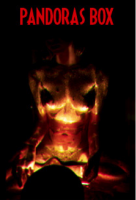
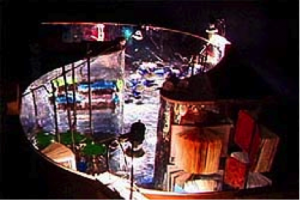
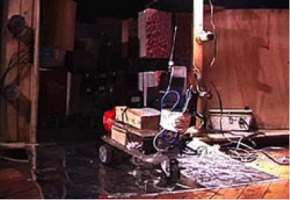
DATE – 1998
DISCIPLINE – Science
MEDIUM – Patent
STATUS – Assignee: Horizonscan Inc.
WEBLINKS
Patent number: 6914622
Abstract: This invention relates to an apparatus for the projection of a remote conferee’s presence into a group meeting environment by using a combination of videoconferencing/teleconferencing and robotics technology. The remote conferee’s face is shown substantially life-size on a video monitor. The remote conferee’s eyes appear to be looking directly at the viewer. The video monitor can turn left or right to point at the person speaking, automatically or by manual control, to give the impression that the remote conferee is turning his head to look at the person speaking. The video screen can be raised and lowered to give the impression that the remote conferee is standing up and sitting down. An attention-getting mechanism prompts the attention of the other conferees when the remote conferee wants to interrupt or enter a conversation.
Type: Grant
Filed: May 6, 1998
Date of Patent: July 5, 2005
Assignees: Telbotics Inc.
Inventors: Graham Thomas Smith, Deborah Ingrid Fels, Jutta Treviranus
DATE – 1993-1995
DISCIPLINE Education
THE BULLETIN, University of Toronto, December 13, 1993
Art for Technology’s Sake – If the medium is the message and the artist is the letter carrier in the Virtual Reality Artist Access Program.
By David Todd
Fred trundles along the carpet, trailing his electronic vocal cord. The evenings addition of electronic traffic, and open house organized regularly by the McLuhan program in culture and technology is in full swing and all eyes are corrected for work. A remote-controlled robot 20 cm in height with a small video camera mounted atop a wheelbase, Fred is navigating through a series of miniature art installations known as the Toronto cyber city as the robot explorers the Lilliputian and surroundings his TVR transmits images along the videoconferencing line to room in sunny Santa Monica.
There are artists Kit Galloway and Sherry Rabinowitz take turns stabbing at the buttons on the keypad in front of them. Thanks to the high-tech magic of the videophone link they are able to operate Fred’s controls from thousands of miles away as easily as if they were sitting in the same room. It’s an object lesson in the power of contemporary Cuban vacations technology to obliterate geographical distances and as it happens an excellent way to inspect suspect footwear fashions in distant locales. While the two Californians are clearly taken the sandbox sized artworks Rabinowitz also seems to enjoy using friends and co-adage to scrutinize some of the varieties of shoes on display at Toronto this evening. Under her direction robots gaze lingers particularly long on a splendid pair of red and blue suede platform boots.
Through it all for its creators of slim bearded figure in a free Tibet T-shirt, hovers attentively. Graham Smith the project leader for the McLuhan program’s virtual-reality artist access program VRAAP and the host of this evenings proceedings is helping his mechanical offspring through its paces bending down periodically to untangle long cord and setting the robot back on course when it plowed into the walls of an installation. At the end of the demonstration Smith introduces the artists involved holds up Fred to the videoconferencing camera so that Galloway and Rabinowitz can take a good look.
I’m working on a second robot he announces smiling like a proud father I think we’ll call it Fred.
Though he resembles no one so much as the guy behind the counter at the local comic book shop, Smith is arguably the living archetype of the artist in an age of such advanced directive dedications technologies as video conferencing and virtual reality. A mixture of a mixture of media junkie visionary cyberpunk and basement inventor he seems equally at home dropping references to the Flintstones and Star Trek were discussing the room entries of Buddhist philosophy. In his works that bears out the truth of one of n Marshall McLuhan’s central maximums namely that the media are too important to be entrusted to the care of business. Rather they belong in the hands of artists because as the celebrated communications guru once wrote they are art forms.
It is precisely this that has lead the McLuhan Program, under the directorship of Derrick de Kerckhove, to foster relationships with artists like Smith who share an interest in communications technologies. “It all goes back to McLuhan teaching me as a student that if you want to understand the impact of technologies on culture, you must never forget the importance of the artist,” de Kerckhove says. “The artist is the one who interprets culture and helps develop the new sensibility that will accompany the change brought about by technology”.


DATE – 1995
DISCIPLINE – Art
MEDIUM – Interactive robotic installation
STATUS – Displayed at the Net@works exhibition, National Centre of the Arts Mexico City
WEBLINKS
http://www.brookemediaarts.ca/exhibition/networks/gallery/smith.html
http://www.brookemediaarts.ca/exhibition/networks/gallery/curatorial.html#smith
In the 1994 cultural exchange between Canada and Mexico, the exhibition “Los Colores de la Voluntad”, a meeting of the minds of new media and computer artists initiated the concept of an exchange exhibition from Toronto to Mexico City of Computer Art, New Media and Technology. In the following documents and visual support material you will see how this idea has unfolded into a powerful display of work from Toronto, interconnecting it with an international multi-media exhibition from one of Torontos major institutions.
Selected works from TechnoArt, curated by Faye Greaves, of the Ontario Science Centre and Derrick de Kerckhove of the McLuhan Program, along with a collective of Canadian artists from Toronto curated by Steev Morgan, “Net@Works”, create the next cultural exchange art exhibition that travels to Mexico from Canada. Included in the program is a lecture series comprised of 6 artists from TechnoArt and “Net@Works”. They will travel to Mexico to install their work and give lectures and slide presentations about their research and process and Canadian Computer Art, New Media and Technology.
We have been invited to exhibit this work at Centro Nacional de las Artes in Mexico City. This is a new institution that opened in November of 1994. It houses all of the schools of art in Mexico City, as well as extended courses in all media; and galleries to exhibit the work of national and international artists. We are working with NAFAA-Mexico, and Director Jorge Morales, and sponsored by the Centro MultiMedia at the CNA and Coordinator Andrea di Castro. Jorge was the curator and coordinator of the Mexican art exhibition, “Los Colores de la Voluntad”, and Andrea is a multimedia artist who came to Toronto as an artist and lecturer with Los Colores.
Th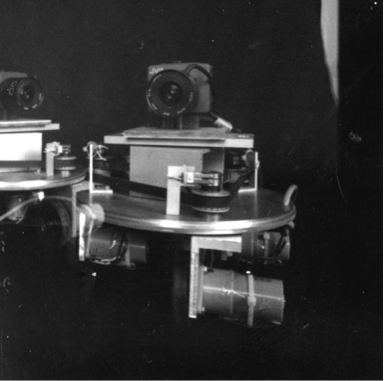 is exhibition is a direct outcome of “Los Colores de la Voluntad”, and an example of how these exchanges can create an ongoing relationship between our two countries and cultures. These events are crossroads, and facilitate new ideas and opportunities for people, artists and institutions of both countries.
is exhibition is a direct outcome of “Los Colores de la Voluntad”, and an example of how these exchanges can create an ongoing relationship between our two countries and cultures. These events are crossroads, and facilitate new ideas and opportunities for people, artists and institutions of both countries.
This project is the continuation of a series of cultural exchanges between Canada and Mexico sponsored by NAFAA. It is through this kind of artistic interaction and Inter-access’ that our two worlds can bridge the gaps between their differences and build a solid base on which we can begin to grow into the future together.
Director – Eleni Mokas
DATE – 1995
DISCIPLINE – Art
MEDIUM
STATUS
This exhibition was exhibited at ISEA in Montreal via a videoconference link Interaccess in Toronto and was linked via ISDN based videoconferencing to numerous sites around the world and allowed the audience to control the robots direction remotely. The Electric Skin exhibition was funded through a Media Arts grant from the Canada Council of the Arts.
ARTISTS
Doug Back, Francis LeBouthillier, Johanna Householder, Simone Jones, Steev Morgan, Jeff Mann, Catherine Orfald, Nancy Nancy Paterson, Kathleen Richardson, Victoria Scott, Graham Smith, Karen Tzventarny, Norman White
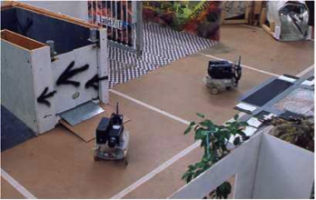

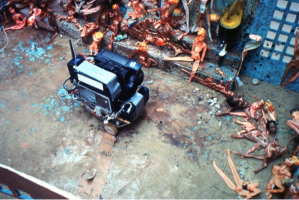
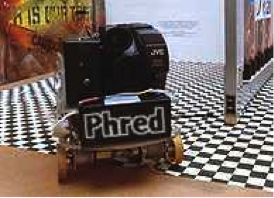
DATE – 1988
DISCIPLINE – Art
MEDIUM – Interactive kinetic sculpture
STATUS – Display at Interaccess in Toronto, Canada
WEBLINKS
http://www.xraylab.org/References/NOW%20On%20-%20Entertainment%20-%20Feature.html

Local artists tackle robotic challenge
By DEIRDRE HANNA
Just imagine something that is not only beautiful but does something meaningful — because it knows how to.
The concept of an intelligent sculpture is singularly compelling, so much so that few art forms carry a sexier cachet than robotics. Yet robotic art, sadly, is still very much in its infancy.
Anyone who wants a taste of where it might be going can get a major hit this weekend with the Spaceprobe exhibit of electro-physical art and the seventh annual Sumo Robot Challenge, which pits mechanized creations against each other in gladiatorial combat.
Fortuitous links
Spaceprobe is the second show the Toronto-based Art and Robotics Group (ARG) has put on at Inter/Access in the past six months, while the Sumo Robot Challenge has become a highlight on OCAD’s academic calendar.
Despite the fortuitous timing overlap, the links between the two events are mostly coincidental. According to artist, teacher and Sumo Robot Challenge coordinator Norman White, about three-quarters of ARG’s members have passed through various programs at the college.
ARG director Jeff Mann is adamant that his group’s creations have little to do with OCAD’s electronic sumo wrestlers.
“There seems to be a culture around robots,” Mann says from the midst of the Spaceprobe installation. “Autonomous carts that zoom around or the toys that little kids play with tend to be the first things that come to people’s minds.
“That’s fine, but this is something else. I founded ARG to bring together people who want to explore electronics in three-dimensional spaces.
“To some extent, this work is interactive in that there’s control and feedback, but what this show is really about is process. This is the kind of work that doesn’t go anywhere until you see what actually happens when you try to put it together, and for the past year ARG has met every Tuesday evening for workshops.”
The workshops tend toward the purely practical, with various members outlining tools and techniques they’ve used to make something in particular work. It’s a gritty, hands-on approach that for Mann represents a reversal in the computerized direction most electronically driven art is taking.
“When I was at OCA, everyone in my program was working with motors, and I was trying to get people to write software. Most of what I’ve done since then is in the box, using computers, video and sound, but I find that stuff leaves me cold.
“Dealing with space, not just the virtual, is far more interesting.”
Mann’s own Spaceprobe offering, Spirit Catcher, is elegant and deceptively simple. A transparent plastic sheet billows above a white-housed fan while discrete antennae sense changes in electrical fields made by the movement of the plastic. These fluctuations are reflected in changes in the sound emitted by three tinny speakers.
Punning organ
Other highlights include James Ruxton’s Heavy Breathing, a device that amplifies the viewers’ breath; Rob Cruickshank and Wendy Whaley’s Transmit/Reflect, featuring a vagina-esque booth that uses a laser to transmit images of those who enter to a fur-lined viewer; Graham Smith’s reflective, revolving Rain Sphere; and Paul Davies’ The Quantification Of Humans, a sisal mat that shows the relative position of those standing on it on a tiny neon chart.
Robert Erlich’s No Escape roves around like a Jetsons-era robotic cart while projecting images between Inter/Access and Gallery 1313, in the heart of Parkdale. Robert Bernecky and Brad Harley take a comical turn with their Windows Of Opportunity, an off-key, pun-rich organ made from PVC pipes and rubber flipflops that plays a painful rendering of Mary Had A Little Lamb.
Other pieces are far less rewarding. Mann reveals his acute awareness of Spaceprobe’s unevenness when he quickly notes that this show is completely uncurated. A week after the opening, two participants still haven’t completed their installations. Shortcomings aside, however, Spaceprobe bristles with potential.
And the Sumo Robots are always a blast. As White observes, “It’s an art form that allows for a lot of irony.”